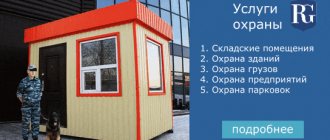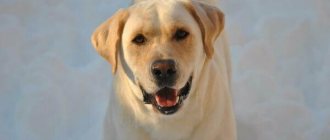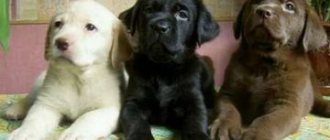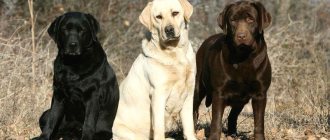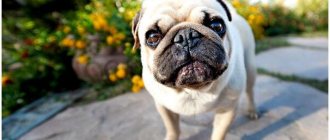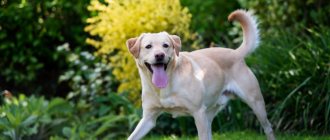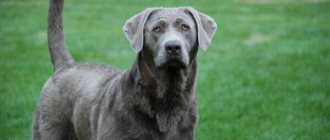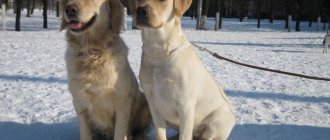- September 10, 2018
- Dogs and hunting with them
- Lidiya Sherstova
Labrador is a breed of gun hunting dog, classified by the FCI classification in the first section of the eighth group (retrievers). Currently, these animals are used for various purposes, including as family companions and pets. Beautiful external characteristics were the reason for breeding the breed for exhibition shows. However, we should not forget that Labradors were originally hunting dogs intended for a certain type of work with game, namely “find and bring.”
General characteristics of the breed
The Labrador Retriever is of British origin. Presumably the breed was formed as a result of crossing Newfoundland dogs with a curly-coated retriever, an English foghound and a setter.
The Labrador is a medium-sized dog with a compact, strong constitution, a wide skull and a massive muzzle. According to the standard, the body should not give the impression of being overweight and overweight. The Labrador's constitution must correspond to its working qualities (activity, endurance, etc.).
This dog is very beautiful, friendly, intelligent and very trainable. Such qualities have led to the popularity of breeding Labradors as pets.
Appearance
The breed standard establishes the breed characteristics that a Labrador Retriever must meet:
- The Labrador is a strong-built, well-built, energetic dog.
- The Labrador's skull is wide, with a clearly defined transition from the forehead to the muzzle.
- The muzzle is massive, not lightweight.
- The nose is wide, pigmented, the nose is wide, with well-developed nostrils.
- The labrador's jaws are of medium length and powerful. The teeth are strong with a perfect, regular, fully scissor bite.
- Eyes of medium size, expressive. Eye color is brown or hazel.
- The ears are hanging, medium in size, not heavy, set closer to the back of the head, and fit rather tightly to the head.
- The Labrador's neck is strong, firm, and dry.
- Smooth topline, straight back, short and strong loin, strong, wide hindquarters, without sloping towards the tail.
- The Labrador's chest is wide and deep, with barrel-shaped ribs.
- The forelegs are strong and strong, straight from the elbows to the ground, both in front and from the sides.
- Knees with clearly defined articulation angles. Hocks are short.
- The paws are round, the toes are tightly adjacent to each other, the paw pads are well developed.
- The Labrador's tail is of medium length, thick at the base, gradually tapering towards the end. The tail is devoid of dewlap, but is covered with short and thick hair and should not curl over the back.
- The Labrador's coat is “double” and consists of hard, short and straight guard hair, without waves or fringes, and a dense undercoat that protects the Labrador from cold water and bad weather.
- Labradors come in three colors: solid black, fawn, and brown (liver or chocolate). In black and brown dogs, the breed standard allows for a small white spot on the chest. The fawn color can be of various shades from light cream to fox red.
- The height of a Labrador is 56-61 cm in males and 52-56 cm in females. Labrador retrievers weigh 27-40 kg for males and 27-35 kg for females.
- A Labrador's movements should be free, straightforward, and correct.
- The average life expectancy of a Labrador is from 10 to 14 years, it depends on the quality of food, physical activity and veterinary control.
Many people confuse the two dog breeds: Labrador and Golden Retriever; they are indeed somewhat similar, but there are also differences:
- Color:
The Labrador has three colors: black, fawn and brown; the Golden Retriever has only one - Coat Texture:
Labradors have a short, coarse coat; Golden Retrievers have a flowing, soft coat. - Temperament:
Labrador is a playful, cheerful and cheerful dog, Golden Retriever is a thoughtful and dreamy dog.
Hunting qualities
The main task of a Labrador when hunting is to search for and present game. Therefore, he is classified as a retriever (from the English retriever - “find and bring”). Accordingly, the hunting qualities of the Labrador are most relevant and useful precisely within the framework of this task. This dog is considered highly specialized, unlike the same huskies, which combine the work of both hounds and cops.
At first glance, it may seem that a Labrador's hunting work is not particularly valuable. After all, the main purpose of a dog, fetching, does not help track down and kill game. Nevertheless, after a shot, it can be very difficult for a hunter to find the prey on his own, especially if it is a bird killed at a great distance. The situation is even more difficult in difficult terrain or when game falls into a body of water. In all these cases, the Labrador comes to the rescue. Using a highly developed sense of smell and visual spatial orientation, the dog finds the shot game along the shortest path and brings it to the owner.
The following qualities help the Labrador in this type of hunting:
- acute sense of smell;
- good memory (the dog can search for game not only by smell, but also visually remember the place where the animal was shot);
- good endurance - allows the Labrador to act strictly on the orders of the owner, which allows the hunter to focus on the game, and not on controlling the pet;
- ability to work in a team with other dogs (Labradors are sometimes used together with setters or pointers);
- developed intelligence;
- attentiveness to humans and obedience (the dog follows commands even from a distance);
- ability to work in difficult terrain;
- soft mouth (game brought in the dog’s mouth remains intact);
- friendly disposition (in the case of joint hunting, other people may not be afraid to be near a Labrador, since this dog will never show aggression even towards a complete stranger);
- excellent swimmer skills and protection from the cold (the dog can easily swim after a downed bird even in the autumn-winter period);
- good endurance.
In addition to fetching, a Labrador can track down a skillfully hiding bird and lift it onto the wing so that the hunter can shoot. The dog is also capable of finding wounded animals using a blood trail. Depending on the specific region and the personal preferences of the hunter, Labradors can be used only for presentation, or also for searching.
When hunting, Labradors are distinguished by their leisurely and quiet progress in their search. They usually do not stray far from their owner and do not rush after game without orders. They take shots calmly. According to reviews, the Labrador is excellent at presentation when hunting, especially when retrieving game that has fallen into the water. The "swims like a walrus" characteristic is ideal for this breed. Ice water, like cold weather, is also not a hindrance for a dog. But Labradors do not tolerate heat well.
The breed is suitable for hunting:
- waterfowl (duck, goose, etc.);
- birds living on land (great snipe, pheasant, partridge);
- small animals (fox, hare, rabbit).
Labrador retrievers can be used in both solitary and group hunting. In the latter, there are two varieties for which dogs of this breed are ideally suited - penned and walking.
Golden retriever
These amazingly beautiful dogs are no less popular among hunters than the more massive and slow Labradors. Representatives of this breed do not throw themselves into the water so selflessly, but they work much more enthusiastically and with better quality in hunting upland game. Even without special training, they quite correctly scour the lands, forests and swamps, always within the reach of the owner, wait for him, pick up and bring game.
These dogs are kind and flexible, well trained. They can't stand rudeness. If a puppy is raised using harsh methods, he becomes withdrawn and becomes a frightened coward.
Handsome golden retriever
In appearance, the Golden Retriever is slightly different from the Labrador and is somewhat reminiscent of the Scottish Setter - slightly taller, more massive - weight up to 34 kg, longer coat, different shades of golden. The year of birth of the breed is considered to be 1865, when the famous hunter yellow labrador named Nu became the father of a litter of puppies from a bitch of the now extinct breed of tweed water spaniel.
Hunting in drives
The essence of this hunt is that the game is driven by a group of beaters to a line of hunters with guns, who shoot. Then, on command, the dogs rush to search for killed animals or birds and bring them to their owners. In this case, Labradors act along the shortest possible path. The latter is necessary not only to save time, but also to avoid spooking the game hiding nearby.
Before being sent to retrieve, the dog should not move from its place, remaining close to the person, which requires enormous endurance from it. In this sense, the Labrador is an ideal breed.
Typically, game is sought out and presented within 100-200 meters of the hunter. If several pieces were killed at the same time, the dog works in the direction indicated by the leader. This measure excludes the provision of prey to someone else's hunter.
Advantages and disadvantages
Advantages of Labrador
The Labrador has a huge number of advantages that have made this dog breed so popular all over the world:
- Balanced psyche
- Boundless devotion to the owner and his family
- Kindness towards people and animals
- Calm attitude towards other pets, including cats and other dogs
- Short hair requires virtually no maintenance
Disadvantages of Labrador
With all the advantages of Labradors, they also have small disadvantages:
- Labrador is a dog that requires walking and good physical activity, regardless of the time of year and weather conditions.
- A friendly attitude towards everyone, including strangers, does not allow one to consider a Labrador a good watchman
Duck hunting with Labrador
Duck hunting is a classic use for the Labrador. In this case, the dog acts on the principle of retrieval, bringing prey to the owner directly from the water. Hunting for goose and other waterfowl is carried out in a similar way.
If the duck is on the ground, the Labrador is able to put it on the wing under the hunter's shot, and then find it and bring it back. Due to its endurance, the dog can do this many times, picking up all the killed birds.
It is duck carcasses (and their stuffed animals) that are used to teach Labrador hunting skills, as well as in working tests of the breed.
Features of hare hunting
Hunting a hare with a Labrador is less typical than hunting birds, but the dog copes with this task. If the work is carried out only with a retriever, the latter’s task will include tracking and driving out game, and not just retrieving.
First, the Labrador looks for a hare sitting in a shelter. The dog's chances increase in conditions of rain, wet snow or thaw, since then the animal hides under fir trees, dead wood and in other places that are easy for a hunter to stumble upon. Having discovered the target, the Labrador raises the hare to shoot. This usually happens at a distance of 20-40 meters from the hunter.
If tracking and driving the animal is carried out by other breeds of dogs, the retriever performs only its usual work - fetching and searching for wounded animals.
Maintenance and care
When keeping a Labrador in your home, you should pay attention to some points:
- If not fed correctly, Labradors can quickly gain excess weight. A small puppy is fed 6 times a day, a puppy aged 6 months is fed 3 times a day. When feeding a puppy natural food, feed the puppy soups with meat broth, liquid porridge with milk, give him lean meat, cottage cheese and vegetables. An adult Labrador is fed 2 times a day. His diet includes boiled meat, cereals, fermented milk products, and fresh vegetables can be given in summer.
- Labradors are very active dogs, they love movement. An adult Labrador needs to be walked twice a day: at least half an hour in the morning and two hours in the evening. Adult Labradors need long walks, otherwise, without good physical activity, they splash out their irrepressible energy on pranks and hooliganism. Labrador puppies require extensive play and training sessions.
- The Labrador's thick, waterproof coat does not require special care; combing and brushing 1-2 times a week is sufficient. During the molting period, the amount of scratching is doubled. You need to bathe your Labrador when it gets dirty.
- Labrador's ears, like other dog breeds with floppy ears, require regular inspection for the presence of ear parasites and cleaning of dirt that accumulates there. Labradors are susceptible to otitis, including infectious ones, so do not neglect ear care.
Any difficulties of keeping a Labrador in your home are more than compensated by the joy that these dogs bring to their owners.
Education
The Labrador is a type of dog that is very easy to train. And education is where you should start working with your pet before training him to hunt.
You need to start training from puppyhood, teaching the dog to fetch and basic commands. It is recommended to do this in a playful way, which contributes to:
- establishing contact between owner and pet;
- the puppy develops an interest in following commands.
A regular ball is ideal for practicing the basics of fetching. The puppy is taught to fetch it and also to remain in place until the command is given.
Typically, Labradors are very obedient dogs, deeply loyal to their owner. Therefore, there are no difficulties in raising them.
Hunting training
In order for a Labrador to be used as a real hunter, the dog’s natural qualities alone will not be enough. All breed skills must be developed, as well as the dog must be taught to work as a team with a person. Training a Labrador to hunt begins at six months of age and can be carried out either by the owner himself or by a dog handler. If there is no practice in training hunting dogs, it is better to leave this matter to a specialist.
Hunting training includes four main stages:
- retrieval (search and presentation) of “visible” game on land;
- fetching invisible game on the water;
- training in searching and presenting “hidden” game (on land and on water);
- working out the Labrador recall after sending.
The first and second stages differ only in the nature of the terrain. The drill is based on three sequential commands: “Give it!”, “Come to me!”, “Give it!”. Before sending, the game (duck carcass or stuffed animal) is thrown at a distance of about 15 meters.
At the third stage, the dog can no longer rely on vision, because it does not see where the diarrhea was placed. In this case, the Labrador searches for game solely by smell. The distance at which the target is hidden gradually increases from 5 to 20 meters.
At the fourth stage, the Labrador is taught to stop fetching using the command “Ugh!” A timely response to such an order from the owner is necessary to prevent situations that are dangerous for the dog, since hunting is carried out using firearms. It is also important to practice the retriever's endurance. The dog must stay close to the person and not rush at the game without an order, even after a shot.
Water Spaniels
American and Irish water spaniels are much smaller - up to 40 cm in height and up to 20 kg in weight. The American is not distinguished by its beauty - its color is liver, its coat is curly and very dense. The dogs have excellent hunting qualities and obedience. But they require careful care - the dense wool is constantly filled with burrs and thorns.
American Water Spaniel
The Irish Water Spaniel was bred in Ireland, but the breed quickly won the love of hunters in Great Britain and continental Europe, and also conquered North America and Canada. The dogs are larger than their American counterparts, have thick, curly fur of a red-brown color, with a dense undercoat, and withstand frost well. In Russia, representatives of this breed can be counted on one hand, and they are mostly kept as show dogs.
Irish Water Spaniel
